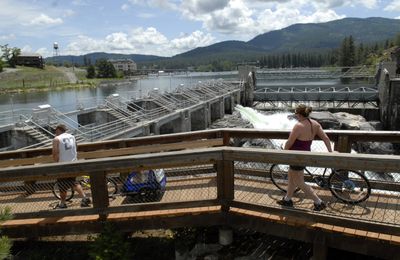Power play: Avista dams relicensed
Avista plan reflects new emphasis on recreation, environment

Five hydropower dams on the Spokane River are entering a new era. Avista Corp. received a new federal license for the dams Thursday that spells out how they will operate over the next 50 years. “It’s a new chapter for the Spokane River,” said Rachael Paschal Osborn, the Sierra Club’s river project coordinator. Recreation, water quality and fisheries are addressed in the license. The Sierra Club was among 200 groups that took part in the five-year relicensing process. The strong public participation didn’t surprise Speed Fitzhugh, Avista’s license manager. “The Spokane River is such a key feature in this area,” he said. “It runs right through the heart of the city.”
Q. Which dams are covered by the agreement?
A. Post Falls, Upper Falls, Monroe Street, Nine Mile and Long Lake.
Q. Who issued the license?
A. The Federal Energy Regulatory Commission.
Q. What’s in the license?
A. Requirements for river flows, fish habitat and water quality monitoring, among other things. Recreation gets significant attention.
Q. How much will the new license agreement cost? Who pays?
A. Avista expects to spend more than $300 million to meet the new conditions. Utility customers will pay the costs over the next five decades.
Avista is asking Washington electricity customers to pay $6.7 million for dam relicensing as part of its current rate case. Idaho customers would pay $3.8 million. It would be a small part of each monthly bill, according to the utility.
Q. How will river recreation improve?
A. Avista will spend nearly $400,000 annually to add and upgrade recreational sites. Projects include new public access for boaters, including 10 boat-in only, semi-primitive campsites on Long Lake.
Trails and interpretive signs will be improved at Falls Park and Q’emiln Park in Post Falls. Work will also take place at the Higgens Point boat launch on Lake Coeur d’Alene.
Q. What about the “Trailer Park Wave”?
A. Avista agreed to study better access to the rapid that whitewater kayakers use below Post Falls Dam. To reach the wave, kayakers have to carry their boats a quarter-mile to put in and paddle a half-mile to the site. Avista will study the possibility of parking, a carry-in boat launch and a toilet.
Q. How will fisheries be affected?
A. Water releases from Post Falls Dam will improve native redband trout habitat.
The license also requires studies of bull trout, westslope cutthroat and surveys of other fish on certain stretches of the river.
In addition, Avista will stock 155,000 sterile rainbow trout in Long Lake each year for five years for recreational fishing. If it proves popular, the stocking will continue.
Q. Are there any other natural-resource requirements?
A. Yes. To name a few: Avista will survey bald eagles and prepare a plan to keep raptors from getting hurt or killed on transmission lines. Avista will increase summer aesthetic flows over Spokane Falls.
The utility must manage aquatic weeds on Long Lake and Lake Coeur d’Alene.
Q. Why so much focus on recreation and the environment?
A. Avista’s Fitzhugh says the focus is part of the Electric Consumer Protection Act of 1986.
The act requires the Federal Energy Regulatory Commission to give recreation and the environment the same consideration as power generation when issuing new dam licenses.
Q. Is a settlement with the Coeur d’Alene Tribe part of the license?
A. Yes. The license includes most of the cost of storing water for hydropower generation on the tribe’s submerged land in Lake Coeur d’Alene.
Q. How much electricity do the dams produce?
A. About 10 percent of Avista’s electricity comes from the Spokane River dams.